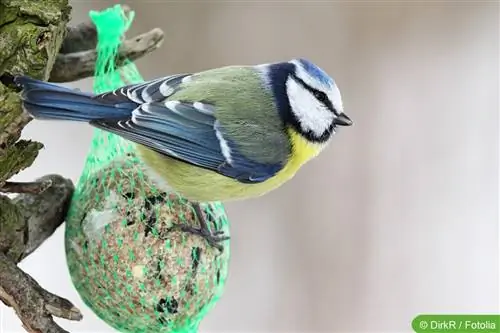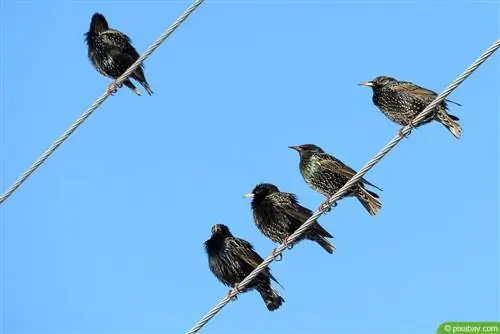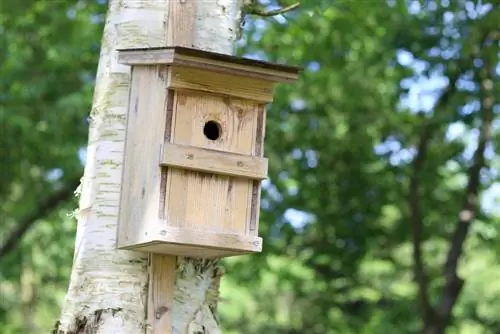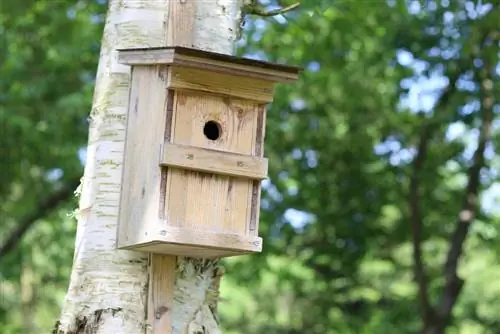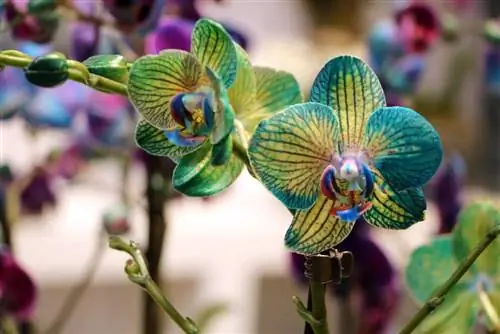- Author admin [email protected].
- Public 2023-12-17 03:39.
- Last modified 2025-01-24 12:45.
Blue tits are one of our smallest native songbird species. They are very common not only in Europe, but also in North Africa and parts of Asia. The blue and yellow-feathered blue tit can be found everywhere in our parks, gardens, deciduous and mixed forests. Blue tits are not great flyers, they avoid large open spaces.
Numerous species of birds - including the pretty blue tit - breed exclusively in largely closed nesting holes. However, as natural caves are becoming increasingly rare, the blue tit population is being significantly reduced or even threatened. That's why blue tits have become more and more dependent on us providing them with suitable nesting boxes. It is not the shape or design of the nesting box that is important, but rather the size of the hatch opening. Above all, this can keep away competing bird species but also predators and thus give the blue tit a new home.
Profile
- scientific name: Cyanistes caeruleus
- other names: Parus caeruleus
- belongs to the genus of tits within the order of passerines
- native songbird
- Size: up to 12 cm
- Wingspan: up to 20 cm
- Plumage: blue and yellow
- Age: up to 5 years
- Weight: average 10 grams
Appearance and identifying features of the blue tit
Blue tits can be found throughout Europe except for the far north. Blue tits are found here all year round because they are resident birds that overwinter here. Blue tits are easy to recognize by their distinctively colored plumage. The strong blue parts on the head (cap) and on the wings cannot be found in any other songbird species. The feathers on the belly and chest are light yellow and are separated from the white face by a black-blue neck ring. A fine black line runs almost horizontally through the eye. The blue tit is not only significantly smaller than its relatives, its horn-brown beak is also quite short. In the middle of the yellow belly plumage there is a vertical dark stripe, which is sometimes hidden by the rest of the plumage.
Male and female differ little. On closer inspection, the female blue tits appear somewhat paler. The birds themselves can recognize each other without any problems because the two sexes can be clearly distinguished in the ultraviolet spectrum.
Food Sources
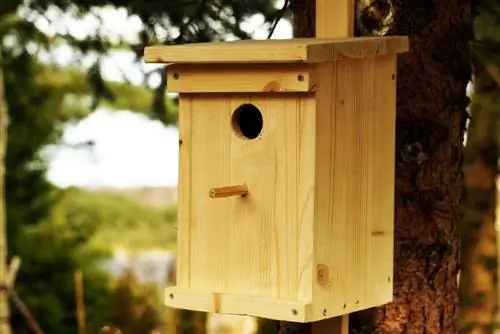
The blue tit's diet consists of a variety of invertebrates, mainly small insects. Since the supply of this live food is very low in winter, the birds adapt and simply become grain eaters during this time. As small as they are, they are not afraid of scaring away other birds such as sparrows, robins or great tits from feeders in winter.
- small insects (flies and mosquitoes)
- Spiders
- Larvae and caterpillars
- Aphids
- Seeds such as beechnuts
On an annual average, animal food accounts for around 80% of total food. Because of its small size, the blue tit primarily hunts prey under two millimeters in length. The food fed to the nestlings is less variable than for adult birds. The main component of the rearing food is butterflies, especially their caterpillars. If this food source is not available, spiders and beetles play an important role.
Tip:
In spring, blue tits also feed on flower buds, pollen and nectar, which is why the blue tit can even act as a pollinator for some plants (crown imperial).
Food procurement
A blue tit is characterized by its extraordinary skill in acquiring food. It is able to cling to thin branches with its feet and hang upside down to search for food.
breeding season
Blue tits generally breed twice a year. The female lays the first eggs (up to 15 eggs) in April. The young hatch after about two weeks and remain in the safe care of the nest for another 20 days. At this time, the peeping of the little blue tits can be heard from all sides, begging their parents for food. The little blue tits are very endangered. Many of them don't even reach their first year of life because enemies are lurking everywhere:
- Cats
- Birds of prey such as sparrowhawks or peregrine falcons
- Magpies and other corvids
- Marten
- also people
Nest location and nest construction
Blue tits build quite elaborate nests as cave nesters. They almost exclusively use caves that already exist, although they are very flexible in their selection. However, they are not content with simply cleaning and padding the cave, but rather invest a lot of time preparing their nesting place. A typical nesting site for blue tits is higher up on the tree and has a tiny opening to prevent natural enemies such as martens or predatory birds from gaining access. The total effort involved in building the nest can easily take two weeks.
- Outer layer: moss and broken individual blades of grass
- Upholstery materials: animal hair and feathers
The right nesting box for the blue tit
Blue tits only nest in enclosed burrows (cave nesters). However, as old trees have become rare, blue tits have problems finding suitable nesting sites. To ensure the continued existence of the delicate, beautifully colored bird, enough nesting boxes should be hung. In order to exclude other birds (especially the main competitor, the great tit), the entrance opening should not be larger than 26-28 millimeters in diameter. Materials for a nesting box:
- Wood (natural variant)
- Wood concrete (stable, weather-resistant, breathable)
Tip:
Blue tits also use unusual places in residential areas to build nests. Columns in masonry or mailboxes are particularly popular.
The right location for the nesting box
Blue tits do not usually nest in gardens because there is simply not enough food in the form of caterpillars to raise their young. However, you can attract a pair of titmice to the garden with a nesting box. Blue tits are very selective when choosing their nesting cavity. The birds can often be observed examining all the options together before making a final decision.
A nesting box for blue tits should be installed at least two to three meters above the ground. It is important to ensure that it hangs really firmly and securely. This means it must not swing back and forth or even fall down in strong winds or storms. In addition, it should not be accessible to the blue tit's predators through lower branches or other climbing opportunities. The orientation of the nesting box also plays a big role. It is best hung with the entrance opening facing east or southeast, so that the first rays of sunshine in the morning warm the box, but the blazing midday sun does not shine on it. This is very important for the development of the sensitive young birds. A new nesting box should be hung in March at the latest. Since many birds do not accept new nesting boxes so well, it is better to place them in the fall.
- Height: at least 2-3 meters
- on a house wall or tree
- Orientation: East or Southeast
- weatherproof
Tip:
Blue tits are very lively birds and are also extremely capable of learning. Blue tits have already been observed opening the aluminum lids of milk bottles (left in front of the front door) to get to the tasty contents.
What you should know about blue tits in brief
- Blue tits build their nests deep down in a nesting box, as this is where their offspring are best protected from enemies.
- The nesting aid should never be exposed to the blazing sun for a long time. Warming by the morning sun, on the other hand, is an advantage.
- The blue tit is slightly smaller than the great tit. You have to take this into account when making the opening in the nesting box.
- For blue tits, the hole must be 2.8 cm in diameter. Three small holes in the bottom are an advantage so that the moisture can drain away.
- The nesting box should be 14 cm x 14 cm x 25 cm. The wood of the nesting box must not be treated with wood preservatives.
- In autumn the nesting box has to be cleaned in order to be fit again for the next year.
- Some blue tits like to spend the night in a nesting box even in winter.
- Several birds often cuddle together in a small house and keep themselves warm. In the morning you see a whole family flying out.
Build your own nesting boxes for blue tits
Construction plans for tit boxes can be found in large quantities on the Internet. With a little craftsmanship you can easily build a nesting aid yourself. Tit boxes consist of just a few parts and are very easy to assemble. Children particularly enjoy it. It is important to reinforce the entrance hole with a metal plate so that larger predators such as woodpeckers cannot enlarge the hole to get to the young birds. Tit boxes are often plundered.

